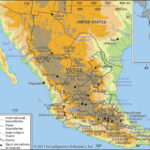ADDRESSING AN EMERGENCY SITUATION: The United States government, under President Donald J. Trump, declared a national emergency citing the extraordinary threat posed by illegal immigration and the influx of dangerous drugs, including fentanyl, under the International Emergency Economic Powers Act (IEEPA).
To address this crisis, President Trump implemented additional tariffs: a 25% tariff on imports from both Canada and Mexico, and a 10% tariff on imports from China. Energy resources from Canada were subject to a lower 10% tariff.
These actions were presented as a means to hold Mexico, Canada, and China accountable for what the administration perceived as failures to halt illegal immigration and the flow of fentanyl and other illicit drugs into the United States.
The orders emphasized that the flow of contraband drugs like fentanyl, through illegal distribution networks, constituted a national emergency and a public health crisis. The administration criticized Chinese officials for not adequately stopping the flow of precursor chemicals used to manufacture fentanyl and for failing to shut down money laundering activities by transnational criminal organizations.
Furthermore, the fact sheet asserted an “intolerable alliance” between Mexican drug trafficking organizations and the government of Mexico, alleging that the Mexican government provided safe havens for cartels involved in the manufacturing and transportation of dangerous narcotics. These activities were stated to have contributed to a significant number of overdose deaths in the United States and were deemed a threat to U.S. national security, necessitating the eradication of these cartels’ influence.
The document also highlighted a growing concern regarding the presence of Mexican cartels operating fentanyl and nitazene synthesis labs within Canada, referencing a study that recognized Canada’s increasing domestic fentanyl production and its expanding role in international narcotics distribution.
USING OUR LEVERAGE TO ENSURE AMERICANS’ SAFETY: The Trump administration argued that previous administrations had not effectively utilized America’s economic strength to secure its borders against illegal migration and combat the fentanyl crisis.
The fact sheet asserted that access to the U.S. market is a privilege, noting the United States’ position as having one of the most open economies globally and the lowest average tariff rates worldwide.
It contrasted the dependence of Canada (67% of GDP), Mexico (73% of GDP), and China (37% of GDP) on trade with the United States, against the U.S.’s comparatively lower reliance on trade (24% of GDP). Despite this, the U.S. was noted to have the world’s largest trade deficit in goods in 2023, exceeding $1 trillion.
Tariffs were presented as a powerful and proven tool to protect national interests. The administration positioned President Trump’s actions as decisive measures prioritizing American safety and national security.
The document contrasted President Trump’s approach with that of previous administrations, stating that they had failed to leverage America’s economic position to advance national security interests, while President Trump was taking action.
PRESIDENT TRUMP IS KEEPING HIS PROMISE TO STOP THE FLOOD OF ILLEGAL ALIENS AND DRUGS: The fact sheet emphasized that President Trump’s election was seen as a mandate to secure the border, and the tariffs were presented as a fulfillment of this promise.
The Biden administration’s policies were criticized for allegedly fueling a border crisis, described as the worst in U.S. history.
The document claimed that over 10 million illegal entries into the United States occurred under the Biden administration, including an increasing number of Chinese nationals and individuals on terror watchlists. It also noted that encounters at the northern border with Canada were also on the rise.
The sustained influx of illegal immigrants was described as having significant negative consequences across various aspects of American life, including straining schools, depressing wages, reducing housing availability and increasing rents, overcrowding hospitals, burdening the welfare system, and contributing to crime.
The fact sheet asserted that gang members, smugglers, human traffickers, and illegal drugs were entering the country across borders. It cited Customs and Border Protection (CBP) data stating that over 21,000 pounds of fentanyl were seized at the borders in the previous fiscal year, purportedly enough to be lethal to over 4 billion people.
Acknowledging that seizures represent only a fraction of the fentanyl smuggled across the southern border, the document highlighted the severe impact of these drugs, stating they cause tens of thousands of American deaths annually, with fentanyl alone attributed to 75,000 deaths per year. This figure was compared to the total American lives lost in the Vietnam War, emphasizing the severity of the fentanyl crisis.
BUILDING ON PAST SUCCESS: The fact sheet positioned President Trump’s tariff actions as consistent with his commitment to ensuring U.S. trade policy serves national interests.
It referenced President Trump’s Presidential Memorandum on American First Trade Policy, which designated trade policy as a critical component of national security.
The document quoted President Trump’s November promise to impose a 25% tariff on all products from Mexico and Canada until illegal immigration and drug flows, particularly fentanyl, were halted.
It highlighted President Trump’s prior actions during his first term, including establishing the President’s Commission on Combating Drug Addiction and the Opioid Crisis and declaring the opioid crisis a public health emergency.
President Trump’s history of prioritizing American interests in trade was emphasized. The fact sheet cited his previous use of tariff threats against Mexico to enhance border security.
It mentioned the implementation of tariffs on steel and aluminum imports as a response to global oversupply that threatened national security.
Furthermore, it referenced tariffs imposed on imports from China in response to intellectual property theft and forced technology transfer, stating that these tariffs were used to leverage a historic bilateral economic agreement.
Finally, the document pointed to the recent use of tariffs to resolve national security concerns with Colombia, resulting in an outcome prioritizing American safety and border security.

